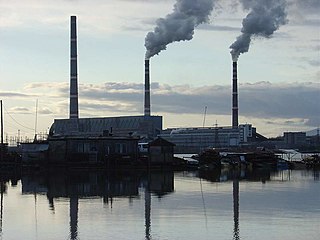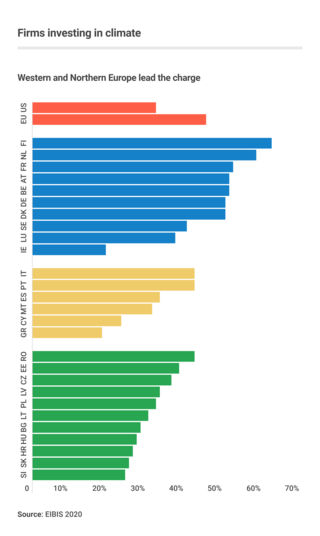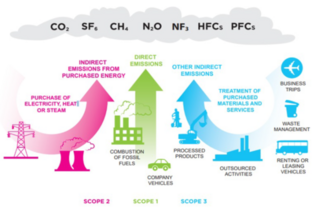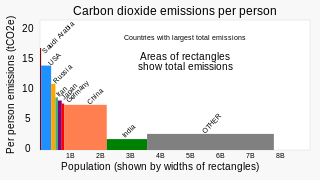Related Research Articles

A carbon tax is a tax levied on the carbon emissions from producing goods and services. Carbon taxes are intended to make visible the hidden social costs of carbon emissions. They are designed to reduce greenhouse gas emissions by essentially increasing the price of fossil fuels. This both decreases demand for goods and services that produce high emissions and incentivizes making them less carbon-intensive. When a fossil fuel such as coal, petroleum, or natural gas is burned, most or all of its carbon is converted to CO2. Greenhouse gas emissions cause climate change. This negative externality can be reduced by taxing carbon content at any point in the product cycle.

Climate change mitigation (or decarbonisation) is action to limit the greenhouse gases in the atmosphere that cause climate change. Climate change mitigation actions include conserving energy and replacing fossil fuels with clean energy sources. Secondary mitigation strategies include changes to land use and removing carbon dioxide (CO2) from the atmosphere. Current climate change mitigation policies are insufficient as they would still result in global warming of about 2.7 °C by 2100, significantly above the 2015 Paris Agreement's goal of limiting global warming to below 2 °C.

The Regional Greenhouse Gas Initiative (RGGI, pronounced "Reggie") is the first mandatory market-based program to reduce greenhouse gas emissions by the United States. RGGI is a cooperative effort among the states of Connecticut, Delaware, Maine, Maryland, Massachusetts, New Hampshire, New Jersey, New York, Rhode Island, Vermont, and Virginia to cap and reduce carbon dioxide (CO2) emissions from the power sector. RGGI compliance obligations apply to fossil-fueled power plants 25 megawatts (MW) and larger within the 11-state region. Pennsylvania's participation in the RGGI cooperative was ruled unconstitutional on November 1, 2023, although that decision has been appealed. North Carolina's entrance into RGGI has been blocked by the enactment of the state's fiscal year 2023–25 budget.

Business action on climate change is a topic which since 2000 includes a range of activities relating to climate change, and to influencing political decisions on climate change-related regulation, such as the Kyoto Protocol. Major multinationals have played and to some extent continue to play a significant role in the politics of climate change, especially in the United States, through lobbying of government and funding of climate change deniers. Business also plays a key role in the mitigation of climate change, through decisions to invest in researching and implementing new energy technologies and energy efficiency measures.

Carbon accounting is a framework of methods to measure and track how much greenhouse gas (GHG) an organization emits. It can also be used to track projects or actions to reduce emissions in sectors such as forestry or renewable energy. Corporations, cities and other groups use these techniques to help limit climate change. Organizations will often set an emissions baseline, create targets for reducing emissions, and track progress towards them. The accounting methods enable them to do this in a more consistent and transparent manner.

C40 Cities Climate Leadership Group is a group of 96 cities around the world that represents one twelfth of the world's population and one quarter of the global economy. Created and led by cities, C40 is focused on fighting the climate crisis and driving urban action that reduces greenhouse gas emissions and climate risks, while increasing the health, wellbeing and economic opportunities of urban residents.

Environmental issues in New York City are affected by the city's size, density, abundant public transportation infrastructure, and location at the mouth of the Hudson River.
The Global Warming Solutions Act of 2006, or Assembly Bill (AB) 32, is a California state law that fights global warming by establishing a comprehensive program to reduce greenhouse gas emissions from all sources throughout the state. AB32 was co-authored by Assemblymember Fran Pavley and Speaker of the California Assembly Fabian Nunez and signed into law by Governor Arnold Schwarzenegger on September 27, 2006.

Greenhouse gas (GHG) emissions from human activities intensify the greenhouse effect. This contributes to climate change. Carbon dioxide, from burning fossil fuels such as coal, oil, and natural gas, is the main cause of climate change. The largest annual emissions are from China followed by the United States. The United States has higher emissions per capita. The main producers fueling the emissions globally are large oil and gas companies. Emissions from human activities have increased atmospheric carbon dioxide by about 50% over pre-industrial levels. The growing levels of emissions have varied, but have been consistent among all greenhouse gases. Emissions in the 2010s averaged 56 billion tons a year, higher than any decade before. Total cumulative emissions from 1870 to 2022 were 703 GtC, of which 484±20 GtC from fossil fuels and industry, and 219±60 GtC from land use change. Land-use change, such as deforestation, caused about 31% of cumulative emissions over 1870–2022, coal 32%, oil 24%, and gas 10%.

The United States produced 5.2 billion metric tons of carbon dioxide equivalent greenhouse gas (GHG) emissions in 2020, the second largest in the world after greenhouse gas emissions by China and among the countries with the highest greenhouse gas emissions per person. In 2019 China is estimated to have emitted 27% of world GHG, followed by the United States with 11%, then India with 6.6%. In total the United States has emitted a quarter of world GHG, more than any other country. Annual emissions are over 15 tons per person and, amongst the top eight emitters, is the highest country by greenhouse gas emissions per person.

China is both the world's largest energy consumer and the largest industrial country, and ensuring adequate energy supply to sustain economic growth has been a core concern of the Chinese Government since the founding of the People's Republic of China in 1949. Since the country's industrialization in the 1960s, China is currently the world's largest emitter of greenhouse gases, and coal in China is a major cause of global warming. China is also the world's largest renewable energy producer, and the largest producer of hydroelectricity, solar power and wind power in the world. The energy policy of China is connected to its industrial policy, where the goals of China's industrial production dictate its energy demand managements.

The Million Tree Initiative refers to the ongoing environmental projects that multiple cities have individually committed to and aimed at expanding urban forestry through the planting of one million trees. This initiative is part of a higher global movement, not only does it intend to act and diminish climate change, it also plans to lower both the urban heat as well as also enhance the air quality in many places. Cities that are known to be currently involved in this initiative are: Los Angeles, Denver, New York City, Shanghai, London, Ontario, and Amherst, New York. A common motive shared between these participating cities is, according to their mission statements, the reduction of carbon dioxide in the air to reduce the effects of global warming. Beyond these environmental advantages, these effort to plant the trees, also shows signs and effects when it comes to biodiversity, improving public health, and fostering sustainable urban development.

Climate change is having major effects on the Chinese economy, society and the environment. China is the world's largest emitter of carbon dioxide, through an energy infrastructure heavily focused on coal. China's per capita emissions are greater than the world and European Union averages but less than Australia, Canada, and the U.S. China recorded its hottest year on record in 2023, with an average temperature of 10.7 °C. On the basis of cumulative CO2 emissions measured from 1751 through to 2017, China is responsible for 13% of global and about half of the United States' cumulative emissions.

A zero-carbon city is a goal of city planners that can be variously defined. In a narrower sense of energy production and use, a zero-carbon city is one that generates as much or more carbon-free sustainable energy as it uses. In a broader sense of managing greenhouse gas emissions, a zero-carbon city is one that reduces its carbon footprint to a minimum by using renewable energy sources; reducing all types of carbon emissions through efficient urban design, technology use and lifestyle changes; and balancing any remaining emissions through carbon sequestration. Since the supply chains of a city stretch far beyond its borders, Princeton University's High Meadows Environmental Institute suggests using a transboundary definition of a net-zero carbon city as "one that has net-zero carbon infrastructure and food provisioning systems".

Climate change in New York City could affect buildings/structures, wetlands, water supply, health, and energy demand, due to the high population and extensive infrastructure in the region. A seaport like New York is especially at risk if the sea level rises, with many bridges and tunnels in the city. Major facilities for Aviation in the New York metropolitan area, and the New York Passenger Ship Terminal, are also located in areas vulnerable to flooding. Flooding would be expensive to reverse. Tide gauge records indicate a rise in sea level of about 50 cm since 1860.
The climate change policy of the United States has major impacts on global climate change and global climate change mitigation. This is because the United States is the second largest emitter of greenhouse gasses in the world after China, and is among the countries with the highest greenhouse gas emissions per person in the world. Cumulatively, the United States has emitted over a trillion metric tons of greenhouse gases, more than any country in the world.

"Sustainability," was defined as “development which implies meeting the needs of the present without compromising the ability of future generations to meet their own needs”as defined by the 1983 Brundtland Commission. As sustainability gains support and momentum worldwide, universities across the United States have expanded initiatives towards more sustainable campuses, commitments, academic offerings, and student engagement.
Green Schools Alliance (GSA) is an effort by primary and secondary schools worldwide to address climate change and conservation challenges by creating a peer-to-peer network of school members committed to reducing their greenhouse gas emissions and accelerating the implementation of sustainable solutions.

As the most populous state in the United States, California's climate policies influence both global climate change and federal climate policy. In line with the views of climate scientists, the state of California has progressively passed emission-reduction legislation.

China's total greenhouse gas emissions are the world's highest, accounting for 35% of the world's total according to the International Energy Agency. The country's per capita greenhouse gas emissions are the 34th highest of any country, as of 2023.
References
- ↑ Cardwell, Diane; Bagli, Charles V. (April 20, 2007). "Mayor To Unveil 25-Year Outline For Greener City". The New York Times. Retrieved May 22, 2010.
- ↑ Werner, Wolfgang (April 29, 2015). "PlaNYC Expands to OneNYC – How Did We Get Here and What's New?". Archived from the original on March 29, 2016. Retrieved January 1, 2019.
{{cite web}}: CS1 maint: unfit URL (link) - ↑ "PlaNYC; A Greener, Greater New York" (PDF). The City of New York. 2007. Retrieved 2019-03-03.
- ↑ "Interim Report for Public Comment" (Press release). NYSDOT. January 10, 2008. Archived from the original on December 14, 2012. Retrieved February 2, 2008.
- ↑ Confessore, Nicholas (April 8, 2008). "$8 Traffic Fee for Manhattan Gets Nowhere". The New York Times. Retrieved April 8, 2008.
- ↑ Confessore, Nicholas (April 7, 2008). "Congestion Pricing Plan Is Dead, Assembly Speaker Says". The New York Times. Archived from the original on April 11, 2008. Retrieved April 7, 2008.
- ↑ Neuman, William (June 26, 2007). "Some Subways Found Packed Past Capacity". The New York Times. Retrieved May 22, 2010.
- ↑ "A Deal, of Sorts, on Congestion Pricing". The New York Times. July 19, 2007. Retrieved August 28, 2017.
- 1 2 3 "PlaNYC Update 2011" (PDF). The City of New York. 2011. Retrieved 2019-03-03.
- 1 2 The City of New York. "PLANYC 2030 - Greenhouse Gas Emissions Inventory". Archived from the original on June 16, 2010. Retrieved June 3, 2010.
- 1 2 Long-Term Plan to Reduce Energy Consumption and Greenhouse Gas Emissions of Municipal Buildings and Operations (PDF), Energy Conservation Steering Committee, July 2008, archived from the original (PDF) on 2010-08-16
- ↑ The City of New York. "PLANYC 2030 - Greenhouse Gas Emissions Inventory: 2007 Emissions Data". Archived from the original on March 26, 2011. Retrieved June 3, 2010.
- 1 2 3 4 "New York City Implements TRIRIGA TREES to Reduce Energy and Carbon Footprint" (PDF) (Press release). TRIRIGA INC. April 13, 2010. Retrieved June 1, 2010.
- ↑ "P&G, Dell, HP, Better Place/Tririga, Harris Corporation, and Aftermarket Auto Parts Alliance Win Awards" (Press release). AMR Research. May 28, 2009. Retrieved June 1, 2010.